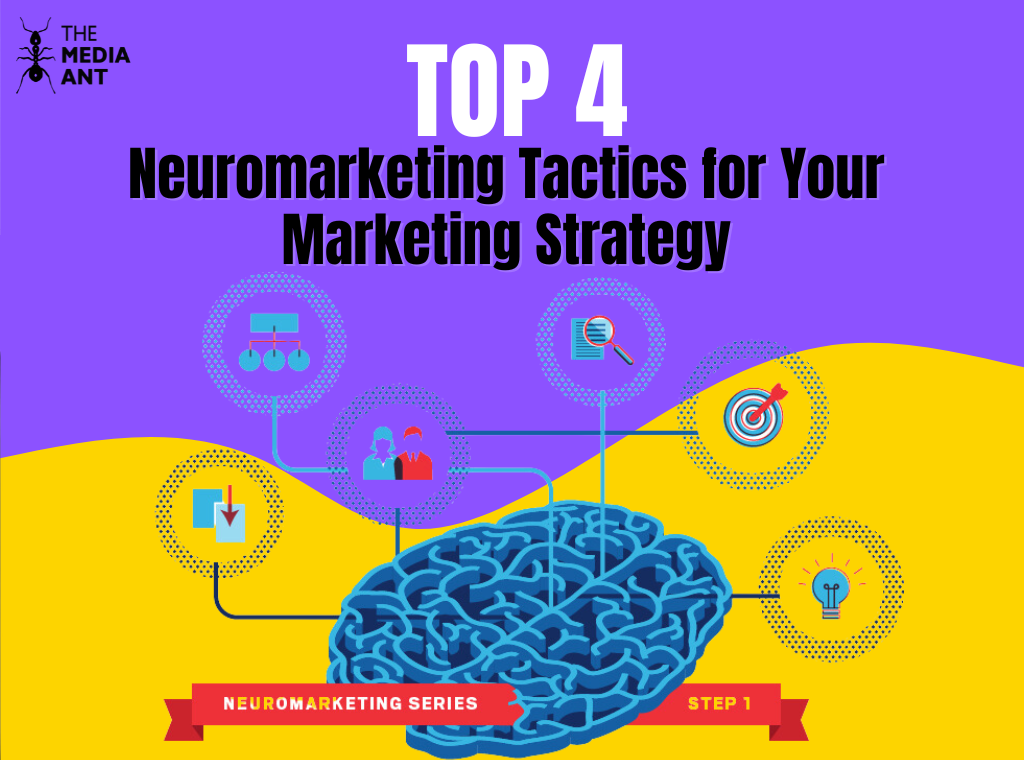Neuromarketing combines neuroscience and marketing to gain a deeper understanding of consumer behavior. By studying how the brain works, businesses can improve their marketing strategies. This guide will discuss effective neuromarketing tactics that engage audiences, increase engagement, and drive sales. By using sensory marketing and emotional storytelling, businesses can create memorable brand experiences that resonate with consumers on a subconscious level. Explore the world of neuromarketing with us and learn how to create impactful campaigns that connect with consumers on a deeper level.
Key Neuromarketing Tactics for Enhanced Marketing Strategies
In a tough market, knowing what makes people buy things without even realizing it is super important for making good marketing plans. Neuromarketing tricks use brain science to make ads that really connect with people. Check out these cool neuromarketing tips to make your marketing even better:
1. Sensory Marketing:
Sensory marketing capitalizes on the power of the senses to create memorable brand experiences. By engaging multiple senses such as sight, sound, smell, taste, and touch, businesses can evoke emotional responses and strengthen brand associations.
For example, the enticing aroma of freshly baked cookies in a bakery or the sizzling sound of food being cooked in a restaurant can instantly stimulate your appetite and enhance your dining experience. Similarly, incorporating sensory elements like vibrant visuals, catchy tunes, or interactive displays in advertisements can help companies leave a lasting impression, differentiating them from competitors.
2. Emotional Storytelling:
Crafting compelling narratives that resonate with consumers’ emotions is a key strategy in neuromarketing. By tapping into their hopes, fears, and aspirations, businesses can establish strong connections with their target audience. Stories that evoke empathy, nostalgia, or inspiration have the power to create lasting brand experiences and drive consumer engagement.
For example, an authentic advertising campaign featuring real-life stories of triumph over challenges can deeply move and motivate viewers. Incorporating emotional storytelling into marketing efforts is a powerful way to build brand loyalty and foster meaningful relationships with customers.
3. Attention-Grabbing Techniques:
In today’s competitive world, grabbing and holding onto consumers’ attention is tougher than before. Strategies to capture attention make use of cognitive biases and visual perception principles to seize attention and shine through the clutter. Striking visuals, captivating headlines, and interactive content are all powerful tools to capture attention and connect with audiences in a matter of seconds.
For example, incorporating eye-catching imagery, contrasting colors, and concise messaging in advertisements can draw viewers’ attention and compel them to take action. By designing marketing materials that are visually appealing and attention-grabbing, businesses can increase brand visibility and drive engagement.
4. Scarcity and Urgency:
Scarcity and urgency are powerful psychological triggers that motivate consumers to take action. By creating a sense of scarcity, such as limited-time offers or exclusive promotions, businesses can tap into consumers’ fear of missing out (FOMO) and drive purchase decisions. Similarly, leveraging urgency through countdown timers, stock availability notifications, or limited inventory alerts can create a sense of immediacy and prompt consumers to act quickly.
For example, highlighting that a product is “selling out fast” or that a discount is “available for a limited time only” can create a sense of urgency and drive conversion rates. By strategically incorporating scarcity and urgency into marketing campaigns, businesses can create a sense of anticipation and compel consumers to make purchasing decisions.
Implementing Neuromarketing Tactics
To effectively implement neuromarketing tactics and enhance your marketing strategies, consider the following steps:
1. Understand Your Audience:
Start by gaining a deep understanding of your target audience’s preferences, motivations, and behavior patterns. Conduct market research, analyze consumer data, and create detailed buyer personas to identify the specific needs and desires of your target demographic. By understanding what resonates with your audience on a subconscious level, you can tailor your neuromarketing tactics to better meet their needs and preferences.
2. Test and Iterate:
Experiment with different neuromarketing tactics through A/B testing and data analysis. Create multiple versions of your marketing materials, such as ads, emails, or website designs, and test them against each other to determine which resonates most effectively with your audience. Pay attention to metrics such as click-through rates, conversion rates, and engagement levels to gauge the effectiveness of each tactic. Iterate on your strategies based on performance metrics and consumer feedback to continuously optimize your campaigns for maximum impact.
3. Personalize Your Approach:
Personalization is key to connecting with consumers on a deeper level. Use data-driven insights to personalize your marketing messages, offers, and experiences based on individual preferences, behaviors, and past interactions with your brand. Tailor your neuromarketing tactics to speak directly to the needs and desires of each segment of your audience, creating a more personalized and relevant experience that resonates with consumers on a subconscious level.
4. Leverage Technology:
Harness the power of technology to implement neuromarketing tactics more effectively. Utilize tools such as eye-tracking software, facial recognition technology, and neuroimaging techniques to gather real-time data on consumer reactions and engagement levels. Analyze this data to gain insights into consumer behavior and preferences, allowing you to refine your marketing strategies and create more impactful campaigns.
5. Monitor Results and Refine Strategies:
Continuously monitor the results of your neuromarketing efforts and use data-driven insights to refine your strategies. Track key performance indicators (KPIs) such as engagement metrics, conversion rates, and sales revenue to measure the effectiveness of your tactics. Use A/B testing, data analysis, and consumer feedback to identify areas for improvement and make adjustments to your campaigns accordingly. By continually refining your strategies based on real-time data and consumer insights, you can optimize your neuromarketing efforts and achieve better results over time.
By following these steps and implementing neuromarketing tactics effectively, businesses can create more impactful marketing campaigns that resonate with consumers on a subconscious level, drive engagement, and ultimately achieve their marketing objectives. For expert guidance and solutions tailored to your marketing needs, consider partnering with The Media Ant.
FAQs on Neuromarketing Tactics:
What are the benefits of using neuromarketing tactics?
Neuromarketing tactics offer several benefits, including a deeper understanding of consumer behavior, enhanced brand engagement, increased conversion rates, and improved ROI on marketing investments. By tapping into the subconscious drivers of consumer decision-making, businesses can create more effective marketing campaigns that resonate with their target audience on an emotional level.
What are three techniques used in neuromarketing?
Three common techniques used in neuromarketing include:
1. fMRI (functional magnetic resonance imaging): Measures brain activity by detecting changes in blood flow, providing insights into consumer responses to marketing stimuli.
2. EEG (electroencephalography): Records electrical activity in the brain, allowing researchers to measure cognitive responses and emotional engagement.
3. Eye tracking: Tracks eye movements and gaze patterns to understand visual attention and preferences, helping optimize marketing materials for maximum impact.
What is the neuromarketing model?
The neuromarketing model is a framework that combines principles of neuroscience, psychology, and marketing to understand and influence consumer behavior. It involves identifying key drivers of consumer decision-making, such as emotions, cognitive biases, and subconscious cues, and leveraging them to create more persuasive marketing strategies.
What is the best neuromarketing advertising?
The best neuromarketing advertising depends on various factors, including the target audience, campaign objectives, and industry context. However, effective neuromarketing advertising typically incorporates elements such as emotional storytelling, sensory marketing, attention-grabbing techniques, and scarcity/urgency triggers. By creating ads that resonate with consumers on a subconscious level and evoke emotional responses, businesses can maximize the impact of their advertising efforts and drive desired outcomes.





